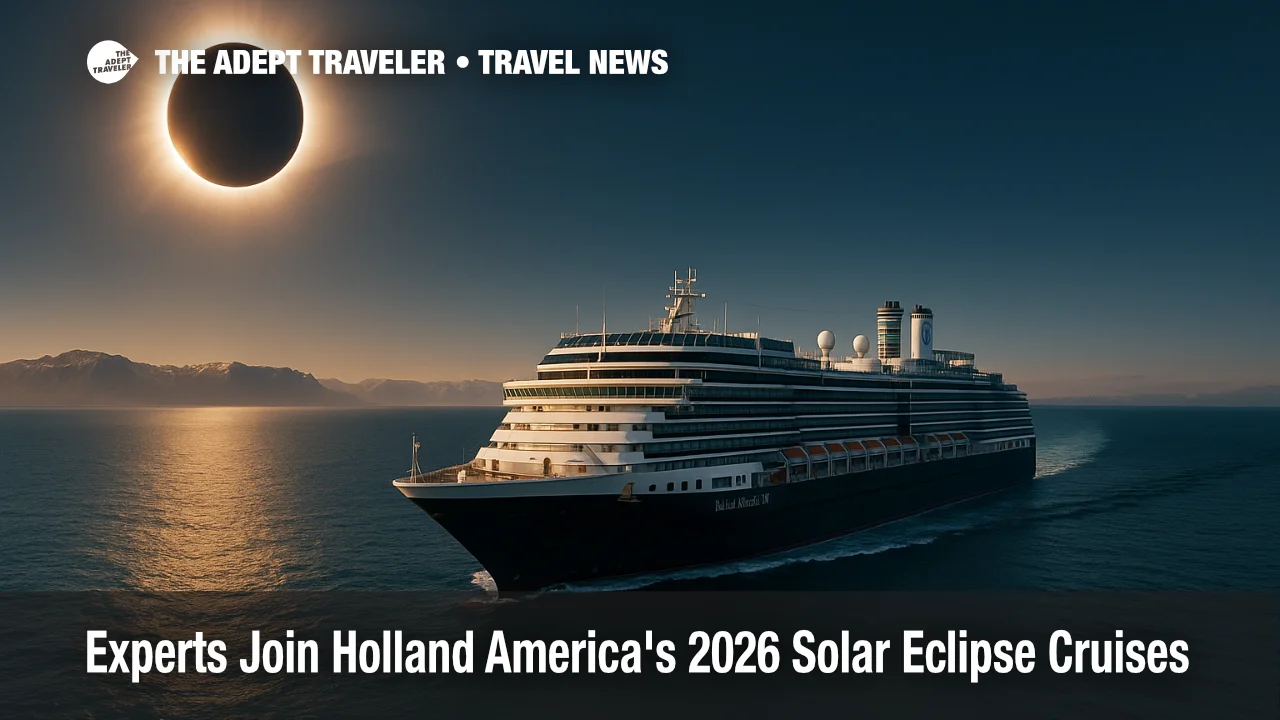Experts join Holland America's 2026 solar eclipse cruises

Holland America Line will place astronomy experts on three sailings timed to the August 12, 2026 total solar eclipse, pairing prime viewing with onboard education. Boston University's Meers Oppenheim will sail on Zuiderdam, UC San Diego's Adam Burgasser joins Oosterdam in the Mediterranean, and longtime educator Tom Vassos will be on Nieuw Statendam's 28-day Greenland and Scotland itinerary. Programs include lectures, Q&As, presentations, and real-time commentary as ships position in the path of totality. Cabins are already available across all three itineraries.
Key Points
- Why it matters: Guided interpretation turns a rare sky event into a deeper travel experience.
- Travel impact: Three itineraries, different regions, broaden options to see totality at sea.
- What's next: Ships plan to position off Iceland and Spain for clear lines of sight, weather permitting.
- Safety glasses and themed activations are planned on eclipse day.
Snapshot
Three Holland America Line itineraries are built around the August 12, 2026 total solar eclipse. Zuiderdam's Voyage of the Vikings includes a 35-day roundtrip from Boston with an 18-day segment option, both aiming for totality near Iceland. Oosterdam operates a 13-day Mediterranean voyage scheduled to be in totality off Spain. Nieuw Statendam runs a 28-day loop from Dover with time in Greenland and Scotland, also targeting totality near Iceland. Each sailing adds an astronomer-led program, with lectures, Q&As, and on-deck commentary during the event.
Background
The next total solar eclipse visible across parts of Greenland, Iceland, and Spain occurs on August 12, 2026. NASA notes that a partial eclipse will be visible across much of Europe and beyond, but totality requires being within a narrow path. By sailing in open water near that path, cruise lines can steer toward clearer skies if local clouds threaten. That mobility, combined with fewer land-based constraints, is why eclipse sailings generate strong interest among travelers who value certainty and comfort. For context on timing and geography, see NASA's future-eclipses overview and detailed path maps from the National Solar Observatory.
Latest Developments
Who is sailing where for the eclipse
Holland America Line named three experts and their assigned ships. Meers Oppenheim, a Boston University astronomy professor and associate director of BU's Center for Space Physics, will be aboard Zuiderdam's Voyage of the Vikings, which offers a 35-day roundtrip from Boston plus an 18-day Rotterdam to Boston segment. UC San Diego physicist and Cool Star Lab director Adam Burgasser joins Oosterdam's 13-day Mediterranean itinerary, scheduled to catch totality off Spain. Tom Vassos, a longtime University of Toronto educator and founder of Cosmologists Without Borders, sails on Nieuw Statendam's 28-day Scandinavian, Greenland, and Scotland program roundtrip from Dover. Holland America's announcement is here.
What you will get on board
Across the trio of sailings, guests can expect lecture series, presentations, special Q&As, and live narration from the experts as the ships set up in the path of totality on eclipse day. The line says it will also provide certified safety glasses and themed onboard programming. Oosterdam's 13-day Mediterranean Solar Eclipse cruise, for example, departs Lisbon on August 9 and includes an overnight in Barcelona plus calls in Spain and Italy, aiming to view totality off Spain.
Analysis of solar eclipse cruises
Holland America Line is leaning into enrichment to differentiate a time-sensitive product. The academic pedigrees are credible, and they match the itineraries. Oppenheim's placement on Zuiderdam lines up with Iceland-adjacent viewing, while Burgasser's Mediterranean assignment targets totality near Spain. Vassos brings long-running public-outreach chops to a longer, northern itinerary where weather flexibility can matter most. Positioning at sea is not a guarantee, but it does improve odds compared with fixed land sites because bridge teams can track satellite imagery, shift course, and work around localized cloud decks. That approach, cited by the line, is the main consumer benefit beyond comfort.
Commercially, the trio gives Holland America Line coverage in two high-interest zones, Iceland and Spain, without overconcentrating capacity in one corridor. It also lets the brand market to different traveler personas, from port-intensive Mediterranean seekers to long-voyage collectors. The add-on programming addresses a frequent gap on eclipse itineraries, where guests see the spectacle but lack structured prebriefs on timing, safety, and what to watch in the corona. If you plan to book, compare where each ship intends to be at maximum totality, plus historical cloudiness along the route, then weigh sea days against desired ports. Finally, verify that certified eclipse glasses are provided and ask about backup plans if weather complicates viewing.
Final Thoughts
A total solar eclipse at sea is unforgettable, and expert guidance can elevate it from bucket-list moment to meaningful learning. Holland America Line's decision to embed seasoned communicators, and to target totality both off Iceland and off Spain, gives travelers real choices across time, budget, and geography. The bet on mobility is smart, since clear skies are never guaranteed. If you are weighing options, focus on where each ship plans to be at maximum totality, then pick the vibe and ports you prefer. For many travelers, that combination is exactly what they want from solar eclipse cruises.
Sources
- Holland America Line Enriches 2026 Solar Eclipse Cruises with the Addition of Astronomy Experts, PR Newswire
- 2026 Solar Eclipse Cruises, Holland America Line
- 13-Day Mediterranean Solar Eclipse with Barcelona Overnight, Holland America Line
- 18-Day Voyage of the Vikings: Solar Eclipse, Holland America Line
- 28-Day Legendary Solar Eclipse with Greenland and Scotland, Holland America Line
- Future Eclipses, NASA
- Eclipse Map, August 12, 2026, National Solar Observatory
